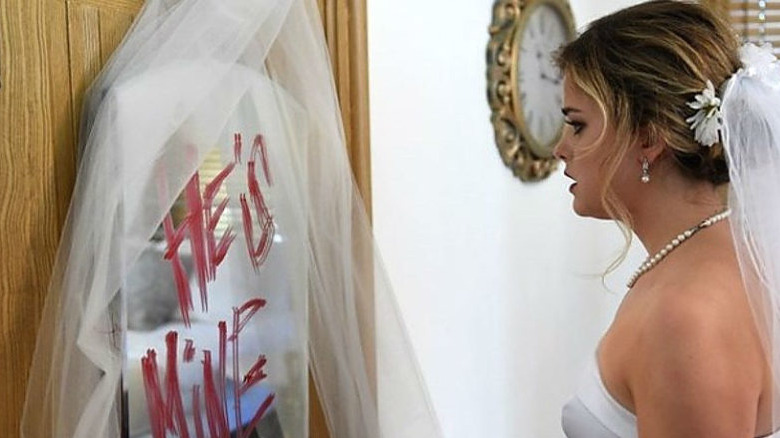The Ending Of You May Now Kill The Bride Explained
While a number of channels have attempted to build a distinct identity for themselves with their programming, Lifetime Television has been particularly successful in this endeavor, helping open the doors for women in Hollywood in the process. This has largely been led by the presence of films exclusively distributed by the channel, the most notable of which are "A Recipe for Seduction," starring Mario Lopez as Colonel Sanders, and "A Deadly Adoption," starring Will Ferrell and Kristen Wiig.
Among Lifetime's more popular offerings is "You May Now Kill The Bride." The film, which aired on Lifetime in 2016, is directed by Kohl Glass and written by Blaine Chiapetta. It follows the story of Mark and Nicole, played by Rocky Myers and Ashley Newbrough respectively, as they find their wedding increasingly fraught with complications as a result of sabotage by Mark's stepsister Audrey, played by Tammin Sursok.
Twists and turns that involve murders, sex tapes, and Audrey pretending to be a stripper at Mark's bachelor party culminate in an ending with a lot to unpack.
Audrey shows her true colors
Right from the surprise engagement at the beginning of the film, Audrey tries to sabotage the imminent wedding of Mark and Nicole. After initially dismissing the idea that Audrey's behind her wedding-related issues, Nicole discovers evidence of Audrey's meddling before Audrey pulls a knife on Nicole, insisting that she can't take Mark away from her. Mark eventually manages to talk Audrey down, and they decide to go ahead with the wedding.
On the wedding day, however, Nicole is in her bridal suite, about to drink some champagne that Mark sent her when she sees the words "He's mine" written on the mirror in lipstick. Audrey ambushes Nicole, steals her wedding dress and wedding ring, and sets her in the bathtub, making her imminent death look like suicide as Audrey goes to the wedding as Nicole.
This is key because it establishes how far Audrey is willing to go to keep Mark. It also solidifies — both with Audrey's actions toward Nicole and her admission — that the woman we see getting killed in the opening scenes of the film was Rachel, Mark's former fiancé, proving that she didn't die by suicide as Mark thinks. While the depths of Audrey's obsession was evident before, this proves the extreme lengths she will go to ensure that she is the only viable romantic partner in Mark's life, as she is willing to not only commit sabotage and psychologically manipulate people, but commit murder if she decides it's needed.
Mark finally sees through Audrey
Mark sees Audrey at the altar and is initially confused before he comes to the realization that Rachel was actually murdered by Audrey. Concerned for Nicole's well-being, he rushes to the bridal suite and pulls her out of the water in the bathtub, trying to revive her via CPR. Audrey arrives and tells Mark they're fated to be together, preventing him from calling 911 and stabbing him when he tries to push her away. Nicole eventually recovers and she and Audrey fall into the bathtub while fighting, leading Audrey to almost drown. In the final scenes, Audrey, now in a mental institution, plays "he loves me, he loves me not" with a wedding photo.
Mark finally realizing that Audrey was behind the sabotage of his love life is a major moment. Leading up to the wedding, Mark vehemently defended Audrey against Nicole, first endorsing Audrey's idea that she should be the maid of honor at the wedding, then refusing to listen to Nicole when she tells Mark that Audrey was responsible for injuring Celine, Nicole's best friend and designated maid of honor, played by Aubrey Reynolds. Thus, Mark seeing Audrey for who she really is takes away any ability for Audrey to hide her actions or pretend she's doing anything other than trying to keep Mark for herself.
The final scene, which mirrors Audrey's earlier actions as she disposes of her anti-psychotic medication, establishes that her obsession with Mark is still as strong as ever, and the story is far from being over.


